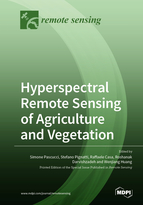Hyperspectral Remote Sensing of Agriculture and Vegetation
A special issue of Remote Sensing (ISSN 2072-4292). This special issue belongs to the section "Remote Sensing in Agriculture and Vegetation".
Deadline for manuscript submissions: closed (31 July 2020) | Viewed by 90706
Special Issue Editors
Interests: multi- and hyperspectral remote sensing for environmental and agricultural applications; imaging spectroscopy; airborne flight campaigns; sensor calibration and validation; ground segment
Special Issues, Collections and Topics in MDPI journals
Interests: hyperspectral remote sensing both from airborne (VSWIR and TIR) and satellite platforms; calibration and exploitation of hyperspectral remote sensing in environmental applications, including agricultural issues
Special Issues, Collections and Topics in MDPI journals
Interests: precision agriculture; remote sensing; agronomic modelling; data assimilation
Special Issues, Collections and Topics in MDPI journals
Interests: remote sensing; vegetation physiological properties; imaging spectroscopy; radiative transfer models; smart agriculture; biodiversity
Special Issues, Collections and Topics in MDPI journals
Interests: vegetation remote sensing; image processing; image classification; parameter mapping; system development; agricultural application
Special Issues, Collections and Topics in MDPI journals
Special Issue Information
Dear Colleagues,
Hyperspectral remote sensing is providing even more research studies and practical applications for agriculture (soils and crops) and vegetation mapping and monitoring, from regional to within-field scales.
In this Special Issue, we welcome papers from the international research community actively involved in research activities on hyperspectral RS (optical domain) for crop and vegetation. The Special Issue is open to all researchers working in these fields. The choice of papers for publication will rely on quality, soundness, and rigour of research. Specific topics include, but are not limited to, the following:
- Hyperspectral studies of agricultural soils, crop, and other vegetation types from ground, drone, air- and space-borne platforms (VIS-NIR, SWIR, and TIR).
- Field, and laboratory hyperspectral measurements for monitoring agriculture and vegetation
- Retrieval of plant traits at leaf and canopy level from hyperspectral measurements
- New methods for hyperspectral data processing and atmospheric compensation techniques
- Hyperspectral sensors calibration and products validation for agriculture and vegetation monitoring
- Statistical and computational methods for hyperspectral data analysis in agriculture and vegetation applications
- Integration or combined use of hyperspectral data from the optical domain with other EO technologies
- Modelling of soils, crops, and vegetation using hyperspectral data
- Next generation hyperspectral technologies and missions, platforms, and sensors for agriculture and vegetation
Dr. Simone Pascucci
Dr. Stefano Pignatti
Dr. Raffaele Casa
Dr. Roshanak Darvishzadeh
Prof. Dr. Wenjiang Huang
Guest Editors
Manuscript Submission Information
Manuscripts should be submitted online at www.mdpi.com by registering and logging in to this website. Once you are registered, click here to go to the submission form. Manuscripts can be submitted until the deadline. All submissions that pass pre-check are peer-reviewed. Accepted papers will be published continuously in the journal (as soon as accepted) and will be listed together on the special issue website. Research articles, review articles as well as short communications are invited. For planned papers, a title and short abstract (about 100 words) can be sent to the Editorial Office for announcement on this website.
Submitted manuscripts should not have been published previously, nor be under consideration for publication elsewhere (except conference proceedings papers). All manuscripts are thoroughly refereed through a single-blind peer-review process. A guide for authors and other relevant information for submission of manuscripts is available on the Instructions for Authors page. Remote Sensing is an international peer-reviewed open access semimonthly journal published by MDPI.
Please visit the Instructions for Authors page before submitting a manuscript. The Article Processing Charge (APC) for publication in this open access journal is 2700 CHF (Swiss Francs). Submitted papers should be well formatted and use good English. Authors may use MDPI's English editing service prior to publication or during author revisions.
Keywords
- Hyperspectral remote sensing for soil and crops in agriculture
- Hyperspectral imaging for vegetation
- Plant traits
- High resolution spectroscopy for agricultural soils and vegetation
- VIS-NIR, SWIR, and TIR
- Hyperspectral data bases for agricultural soils and vegetation
- Hyperspectral data as input for modeling soil, crop, and vegetation
- Product validation
- New hyperspectral technologies
- Future hyperspectral missions










